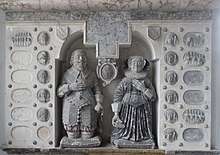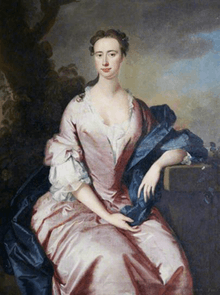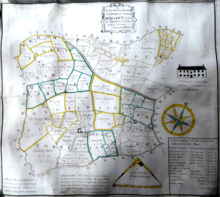Speccot, Merton
Speccot is an historic estate in the parish of Merton in Devon, England.[2][3] It was the seat of the de Speccot family, one of the oldest gentry families in Devon, which founded almshouses at Taddiport, near Great Torrington, Devon, in the 13th century.[4] It is situated about one mile south-west of Potheridge, the seat of the Monck family from before 1287[5] to the late 17th century, who were thus close neighbours of the de Speccot family for many centuries.[6] The present farmhouse known as "Speccot Barton" is Victorian and although no obvious traces of an earlier house survive, is marked "On Site of a Mansion" on the First Edition Ordnance Survey 25 inch map of 1880-99.[7] The estate is today operated as a family-run sheep farm with six holiday cottages to let.[8] A smaller house known as "Little Speccot" is situated on the approach lane to Speccot Barton.

Descent
Theobold FitzBerner

The manor of Spececote is listed in the Domesday Book of 1086 as one of the 27 Devonshire holdings of Theobald FitzBerner (fl. 1086), (Anglicised to "Theobald son of Berner",[9] Latinized to Tetbaldus Filius Bernerius[10]) an Anglo-Norman warrior and magnate, one of the Devon Domesday Book tenants-in-chief of King William the Conqueror. His tenant was a certain "Gosbert", who also held from him the Devonshire manors of South Hole, Milford (both in the parish of Hartland) and Little Marland (in the parish of Petrockstowe), listed with Speccot as successive entries in the Domesday Book.[11] Before the Norman Conquest of 1066 it had been held by a Saxon named "Elaf".[12] His lands later formed part of the Feudal barony of Great Torrington.[13] The Domesday Book entry is as follows:
- Ide(m) G(oisbertus) ten(et) de T(etbaldo) Spececote. Eilaf teneb(at) T(empore) R(egis) E(duardi). Geld(e)b(at) p(ro) una v(irgata) t(e)r(ra)e. T(e)r(r)a e(st) III car(ucis). Ibi e(st) I vill(anu)s, XV ac(rae) p(r)a(tuli), XL ac(rae) pastur(a)e. Olim modo va(le)t VII solid(ii) VI denar(ii). ("The same Gosbert holds Speccot from Theobald. Elaf was holding it in the time of King Edward. It was paying tax for one virgate of land. There is land for three ploughs. There is one villein, 15 acres of meadow, 40 acres of pasture. Formerly (and) now it is worth 7 shillings 6 pennies").
In the Book of Fees (c.1302) Spekcoth is listed as held from the Feudal barony of Great Torrington.[13]
de Speccot

In the mediaeval era it was the seat of the de Speccot family, which the Devon historian Risdon (d.1640) states "it is averred by some" were previously surnamed "Fitz-Barnard"[16] and which during the reign of King Edward I (1272-1307) had taken its surname from its seat when "the addition of Fitz was so frequent with the Normans that to avoid confusion in that kind, men were commanded to assume unto themselves local names".[17] The earliest member of this family identified by Pole was Nicholas Speccot, at the beginning of the reign of King Henry III (1216-1272).[2] In 1438 a licence to hold services in the manor of Speccott was granted by Edmund Lacey (died 1455), Bishop of Exeter.[7]
John Speccot (born 1425) of Speccot inherited the manor of Thornbury in Devon on the expiry of the last male of the Cornu family, as his great-grand-mother was Margaret Cornu, a daughter of Roger Cornu of Thornbury, and wife of Richard Speccot of Speccot.[18] He abandoned Speccot and moved his primary residence to Thornbury, where his descendants remained until the family expired in the senior male line in 1655. The family retained possession of Speccot until after Sir John Speccot (c.1561-1644), MP, of Thornbury, who had a dispute with the Rector of Merton concerning the tithes due from Speccot.[19]
Prominent members of the Speccot family included:
- Ralph Speccot of Speccot, MP for Cornwall in 1341.[20]
- Humphrey Speccot (1532-1558) of Speccot, MP for Plymouth 1577-8[20] and Sheriff of Devon 1585/6,[21] whose son and heir was:
- Sir John Speccot (c.1561-1644) of Thornbury, Speccot and of Penheale in Cornwall,[22] a Member of Parliament for St Mawes in Cornwall from 1604,[21] Sheriff of Cornwall in 1622/3, Sheriff of Devon 1614/15, feudal baron of Great Torrington[23] in Devon and lord of the manor of Holsworthy in Devon. He married Elizabeth Edgcumbe, a daughter of Peter Edgcumbe of Mount Edgcumbe in Cornwall.[24] His monument with effigies survives in Thornbury Church.[25] His sons included:
- Peter Speccot (died 1655), eldest son and heir, of Thornbury and Speccot, MP for Tregony in Cornwall in 1624.[24]
- Paul Speccot (died 1643), younger son, of Penheale in the parish of Egloskerry in Cornwall, who rebuilt that manor house, a Member of Parliament successively for Bossiney, East Looe and Newport all in Cornwall, between 1626 and 1640. His mural monument, erected in 1705, survives in Egloskerry Church, displaying the arms of Speccot impaling Robartes (Azure, three estoiles and a chief wavy or),[26] for his grandson John Speccot (1665-1705), MP for Newport and Cornwall, who married Lady Essex Robartes (d.1689), who died of smallpox three weeks after the wedding,[27] a daughter of John Robartes, 1st Earl of Radnor (1606–1685).
- Sir John Speccot (c.1561-1644) of Thornbury, Speccot and of Penheale in Cornwall,[22] a Member of Parliament for St Mawes in Cornwall from 1604,[21] Sheriff of Cornwall in 1622/3, Sheriff of Devon 1614/15, feudal baron of Great Torrington[23] in Devon and lord of the manor of Holsworthy in Devon. He married Elizabeth Edgcumbe, a daughter of Peter Edgcumbe of Mount Edgcumbe in Cornwall.[24] His monument with effigies survives in Thornbury Church.[25] His sons included:
Rolle
Before 1737 Speccot was owned by the Rolle family of Stevenstone near Great Torrington, one of the largest land-owners in Devon.
Stevens


In 1737 Speccot was purchased from the Rolles by their relatives the Stevens family of Cross, Little Torrington. Henry Stevens (1689-1748), described in his will as "of Smithcott" in the parish of Frithelstock, but who built the existing mansion of Cross between 1744 and 1748,[29] married Christiana Maria Rolle (1710-1780), a daughter of John Rolle (1679-1730), MP, of Stevenstone, in the nearby parish of St Giles in the Wood, and sister of Henry Rolle, 1st Baron Rolle (1708-1750). Portraits of Christiana and of her brothers John Rolle Walter (1712-1779), and Denys Rolle (d.1797), successively owners of the Stevenstone estates, were painted by Thomas Hudson and were given in the early 1900s by Lord Clinton to the Great Torrington Town Lands and Poors Charity. They are on public display in Great Torrington townhall. A "beautifully drawn map" was made of Speccot in 1765 by Malachy Hitchins (1741–1809) for its then owner Richard Stevens of Winscott, Peters Marland.[28] Richard II Stevens (1702-1776) of Winscott, was MP for the Rolle family's pocket borough of Callington in Cornwall between 1761 and 1768. His mural monument exists in Peters Marland Church. He was one of the two sons of Richard I Stevens by his wife Elizabeth, and his brother was Henry Stevens (1689-1748) of Cross, in the parish of Little Torrington. Richard II Stevens (d.1776) married Elizabeth (1707-1760), of unknown family, by whom he had three sons who pre-deceased him without progeny and two daughters who were also without progeny. His daughter Elizabeth Stevens (1727-1792) married firstly Robert Awse of Horwood House in the parish of Frithelstock, and secondly John II Clevland (1734-1817), seven times MP for Barnstaple, of Tapeley near Bideford. Winscott passed after Cleveland's death to the descendants of Richard's elder brother, Henry Stevens (d.1748), of Cross, thus re-uniting the three Stevens estates.
Mallet
In 1810 Speccot was the property of John Mallet.[30]
Risdon
In 1845 Speccot was the residence of Joseph Risdon, Esq.[31]
Luxton
In 1860 Speccot was the residence of John Luxton, yeoman. A coroner's report dated 29 November 1860 concerning a concealment of birth was made as follows:[32]
- On Monday last, an Inquest was held by Richard Bremridge, Esq., County Coroner, at the house of Mr John Luxton, yeoman, at Speccott, in the above parish (i.e.Merton), on the body of a new-born child there lying dead. From the evidence adduced it appears that Mrs Luxton had for some time suspected that her servant, ELIZABETH BLIGHT, was in the family way, and accused her of it, which she repeatedly denied. On Sunday morning, in consequence of information received from her niece, Frances Stevens, who slept with BLIGHT, Mrs L. was induced to go to her bed-room, where she saw appearances which induced her to believe that the servant had given birth to a child. She was questioned on the subject but stoutly denied that any such thing had taken place. Mr Luxton thereupon went to Torrington, and called in the assistance of Dr Jones, who, on going to Speccott, and examining the girl, became fully satisfied that her mistress's suspicions were well-founded. On being pressed on the subject, BLIGHT partially admitted the fact; and on a search being made the body of an infant was discovered on the dung heap near the piggeries, which was subject to post mortem examination by Dr. Jones. It was the body of a fully developed infant, 6 ¼ lbs. in weight and 20 inches in length, and appeared to have been perfectly healthy. the lungs, on being placed in water, did not float, which was an indication that they had not been inflated. Under these circumstances, the Jury returned as their verdict that the child was still-born. The woman thus exculpated from the more serious charge, will, in due course, take her trial for the minor offence of concealing the birth of her off-spring, the Coroner having given directions to that effect.
References
- Hoskins, W.G., A New Survey of England: Devon, London, 1959 (first published 1954), p.435
- Pole, Sir William (d.1635), Collections Towards a Description of the County of Devon, Sir John-William de la Pole (ed.), London, 1791, p.381
- Spelled "Speccott" by the owners in 2018
- "Cornwall | History of Parliament Online". www.historyofparliamentonline.org.
- Pole, p.382 regnal date 16 Edward I
- The Speccot and Monck families appear never to have intermarried (Vivian, pp.568-9, pedigree of Monck)
- "Heritage Gateway - Results". www.heritagegateway.org.uk.
- "Home".
- See Fitz, "son of"
- Genitive case per Domesday Book: Tetbaldi Filii Bernerii
- Thorn, 36:3-6; & notes, list of names.
- Thorn, Caroline & Frank, (eds.) Domesday Book, (Morris, John, gen.ed.) Vol. 9, Devon, Parts 1 & 2, Phillimore Press, Chichester, 1985, Part 1, Chapter 36:5
- Thorn, part 2 (notes), Chapter 36
- Pole, p.502; Vivian, p.706
- Vivian, Lt.Col. J.L., (Ed.) The Visitations of the County of Devon: Comprising the Heralds' Visitations of 1531, 1564 & 1620, Exeter, 1895, p.354
- Risdon, Tristram (d.1640), Survey of Devon, 1811 edition, London, 1811, with 1810 Additions, p.249 re the Speccot family of Speccot in Devon
- Risdon, p.249
- Pole, pp.364,381
- History of Parliament biography
- Vivian
- "SPECCOTT, John (c.1561-1644), of Thornbury, Devon. | History of Parliament Online". www.historyofparliamentonline.org.
- National Archives Cornwall Record Office BW/18/1
- Risdon, Tristram (died 1640), Survey of Devon, 1811 edition, London, 1811, with 1810 Additions, p.362
- Vivian, p.707
- See image
- Cartouche replaced upside down on top of monument, see image
- History of Parliament biography
- Merton local history, Photograph, Object number 230.1
- Slate tablet erected by present owner of Cross, Mrs Rowena Cotton
- Swete, Rev. John, Gentlemen in the County of Devon, published in Risdon, 1810 Additions
- List of subscribers, 1845 edition of A View of Devonshire in MDCXXX: With a Pedigree of Most of Its Gentry By Thomas Westcote
- Inquests Taken Into Suspicious Or Unexplained Deaths For the County of Devon 1855-1864, Articles taken from North Devon Journal, edited by Lindsey Withers